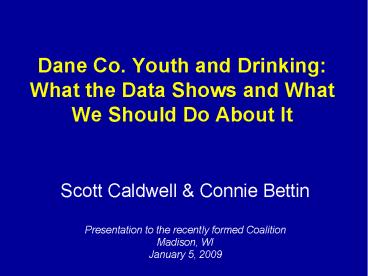Scott Caldwell - PowerPoint PPT Presentation
Title:
Scott Caldwell
Description:
Scott Caldwell & Connie Bettin. Presentation to the recently formed Coalition. Madison, WI ... Adolescence is a unique and powerful developmental period ... – PowerPoint PPT presentation
Number of Views:125
Avg rating:3.0/5.0
Title: Scott Caldwell
1
Dane Co. Youth and Drinking What the Data Shows
and What We Should Do About It
- Scott Caldwell Connie Bettin
- Presentation to the recently formed Coalition
- Madison, WI
- January 5, 2009
2
Three considerations
- Adolescence is a unique and powerful
developmental period - Alcohol use impacts teens differently than adults
- There are multiple pathways to effective
prevention and intervention
3
The Health Paradox of AdolescenceSource Dahl
(2005)
On one hand Measures of most abilities show that
adolescence is the healthiest and most resilient
period of the lifespan
- But on the other hand
- Clinical problems and mortality rates increase
200 to 300 percent
4
- Primary causes of clinical problems and
mortality during adolescence are related to
difficulties with control of behavior and emotion
5
Adolescent Neuroscience
- New science
- Insights into teen behaviors
- Implications for parents, counselors, educators,
policy makers
6
General findings
- Adolescence is a period of unique and profound
brain maturation - Remodeling of structure
- The brain maturation process is not complete
until about age 24!!
7
Research These areas are still developing during
adolescence
CEO judgment, decision making, planning ahead
Directs motivation
amygdala
Regulates emotion
8
Teen Brain Teen Behavior
- Limits to motivation
- Limits to emotional regulation
- Limits to judgments
- preferences for low effort, high excitement
activities - moodiness, quick to anger
- increased risk taking, decreased planning ahead
9
Why should we be concerned about teen drinking?
- Alcohol use amplifies the vulnerabilities.
10
Analysis of Dane Co. youth Brian Koenig,
Principal Investigator
- On-going survey of students 7th 12th grade
- 189 items
- 23,542 students participated (66 HS)
- Voluntary and anonymous
- HS alcohol groups examined
- Abstainers ( 49) No past year drinking
- vs.
- Current drinkers ( 27) At least one drink
during the past 30 days
11
Teen drinking is associated with
- Reduced sensitivity to intoxication
12
Of current high school drinkers, percentage who
reported binge drinking
77
77
Source DCYA (2005)
13
Teen drinking is associated with
- Reduced sensitivity to intoxication
- Involvement with other drugs
14
Current drinking is strongly associated with
past year drug use
Source DCYA (2005)
15
Teen drinking is associated with
- Reduced sensitivity to intoxication
- Involvement with other drug use
- Risk taking
16
Current drinking is strongly associated with
current risk behaviors
Source DCYA (2005)
17
Teen drinking is associated with
- Reduced sensitivity to intoxication
- Involvement with other drug use
- Risk taking
- Risk for cognitive deficits
18
Binge drinking and the teen brain
15 year old male non-drinker
15 year old male heavy drinker
19
Teen drinking is associated with
- Reduced sensitivity to intoxication
- Involvement with other drug use
- Risk taking
- Risk for cognitive deficits
- School difficulties
20
Current drinking corresponds with decreased
school connection, attendance, and grades
Source DCYA (2005)
21
Teen drinking is associated with
- Reduced sensitivity to intoxication
- Involvement with other drug use
- Risk taking
- Risk for cognitive deficits
- School difficulties
- Co-occurring problems
22
Drinking among HS students is linked to
co-occurring problems
Source DCYA (2005)
Any past year delinquency
23
Teen drinking is associated with
- Reduced sensitivity to intoxication
- Involvement with other drug use
- Risk taking
- Risk for cognitive deficits
- School difficulties
- Co-occurring problems
- Risk for long-term alcohol problems
24
Percentages of Past Year Alcohol Problems among
Adults Aged 21 or Older, by Age of First Use
Source SAMHSA (2005)
Early age drinking increases future risk by 6
times
Age Started Drinking
25
The very same brain areas developing during
adolescence are implicated in addiction
26
(No Transcript)
27
Summary of the Data
- Adolescents are not mini adults
- Teens are particularly vulnerable to the harmful
effects of alcohol - Potential risks can be immediate as well as
long-term
28
What to do?Directions for this Coalition to
consider.
29
Selected Principles of Effective
PreventionSource NIDA (2003)
- Start early (preschool, K-6)
- Target key risk and protective factors
- Target developmental transitions
- Utilize multiple strategies, across multiple
levels and settings - Deliver consistent, community-wide messages
30
Five areas to consider
- Involve parents and families
31
My parents think its wrong to drink alcohol
( strongly agree)
AVE 42
Source DCYA (2005)
32
My parents know what Im doing after school
( very often)
AVE 54
Source DCYA (2005)
33
Five areas to consider
- Involve parents and families
- Increase youth perception of risk for alcohol
effects (demand) - Address alcohol accessibility (supply)
- Address alcohol marketing to youth
- Screening, brief intervention, and referral for
treatment (SBIRT) in opportunistic settings
34
What does not work
- Education
- Scare tactics
- Messages to drink responsibly
- Confrontational interventions
35
Questions and Discussion































